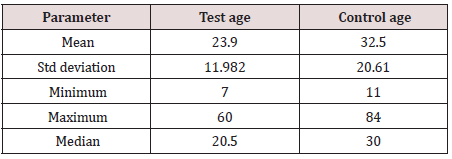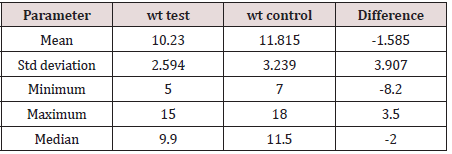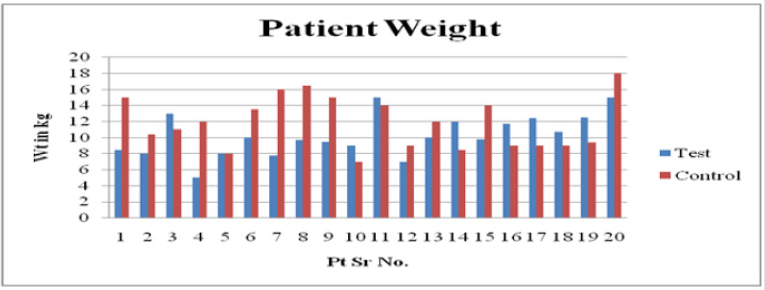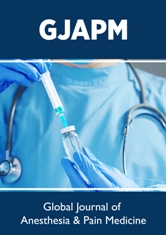
Lupine Publishers Group
Lupine Publishers
Menu
ISSN: 2644-1403
Research Article(ISSN: 2644-1403) 
A Comparative Study Between International Normalized Ratio (INR) Guided Versus Clinical Discretion Guided Blood Component Replacement Therapy in Patients Undergoing Major Surgery Volume 3 - Issue 3
Rajeev Nair1 and Satish Kumar Mishra2*
- 2MD Anaesthesiology HOD Department of Anaesthesiology and critical care Command hospital Airforce Bangalore, India
- 2MD, Dm Cardiac Anesthesia, Department of Anaesthesiology and critical care Command hospital Airforce Bangalore, India
Received: May 29, 2020; Published: June 15, 2020
Corresponding author: Satish Kumar Mishra, MD, Dm Cardiac Anesthesia, Department of Anaesthesiology and critical care Command hospital Airforce Bangalore, India
DOI: 10.32474/GJAPM.2020.03.000164
Abstract
Bleeding is a frequent complication during surgery. The intraoperative administration of blood products, including packed red blood cells, platelets, and fresh frozen plasma (FFP), is often lifesaving. Complications of blood transfusions contribute considerably to perioperative costs and blood product resources are limited. The aim of the present study was to evaluate and compare the usage of INR guided vis a vis clinician discretion based component replacement therapy which will optimize the use of FFP and may even result in less blood loss during surgery. Materials and Method: This study was conducted in surgical patients in a large tertiary care centre. Ethical clearance was taken from the local ethics committee at the proposal stage itself. Patients consent was taken after providing all necessary information prior to surgery. This study was conducted on 200 patients. The groups were randomised to two groups of Gp 1- study(S) -100 patients (point of care-based transfusion management) Gp 2- control (C)- 100 patients (physician discretion-based management). After premedication with intravenous morphine (0.05- 0.1 mg/kg body weight), Glycopyrrolate and ondansetron, General anaesthesia was induced with thiopentone sodium. Endotracheal intubation achieved after vecuronium. Anesthesia was maintained using low flow nitrous oxide: oxygen mixture (fresh gas flow of 1ltr each) and isoflurane (1 MAC) via a closed circuit circle absorber system and mechanical ventilation with 5 – 10 ml/kg. Standard monitoring will include HR, ECG (two lead), blood pressure (NIBP/ IABP), SpO2, naso pharyngeal temperature. Patient warming was done with warm air blower (with a target temp above 36 ̊C). In the control group physician discretion was used to guide Blood platelet or FFP transfusion based on the institutional protocol. These are blood if Hb <8 gm%, platelets if <50,000 or between 50,000-80,000 with ongoing blood loss and FFP if bleeding >20% or >2 units blood given and repeated if physician desires. However, these are guidelines and physician discretion based on clinical judgment is freely allowed. In the test group if bleeding is estimated to be more than 205 CBC and POC INR is done. If Hb < 8 gm% blood is transfused, if platelets <50,000 then 1 Single Donor Platelets or 6 Random Donor Platelets are transfused. 2 units of FFP are transfused if POC INR >1.8. Test was repeated after 30 mins and 2 more units of FFP was given if INR >1.5. Result: there was no difference in age distribution sex weight of patients between the two group, however the need for blood component therapy was in higher in patients who were treated based on clinical discretion compared to INR guided treatment. The mean duration of post-operative ventilation required for the patient to be extubated with stable haemodynamic parameters in the test group was 48.55 hrs compared to 78.4 hrs for the control group. The maximum duration of post-operative ventilation in test group was 212 hrs, compared to 281 hrs for the control group. While the minimum duration was comparable being 18 hrs for test group and 19 hrs for control group. One-Sample Kolmogorov-Smirnov Test was done in each group to ensure normal distribution due to wide distribution of data. From our study we concluded that when in guided blood component therapy was done the need for blood products was much lesser and the need for post-operative mechanical ventilation was much lesser in INR guided group compared to clinical discretion based therapy.
Keywords: INR: International Normalized Ratio; FFP: Fresh frozen plasma; POC: Point of care
Introduction
Karl Landsteiner’s discovery of ABO blood groups in 1900 began
the modern era of transfusion medicine. In 1915 Richard Lewisohn
introduced anticoagulation with sodium citrate. Blood transfusion
was extensively used in world war I and II, with a dictum of “when in
doubt transfuse”. Bleeding is a frequent complication during surgery.
The intraoperative administration of blood products, including
packed red blood cells, platelets, and fresh frozen plasma (FFP), is
often live saving. Complications of blood transfusions contribute
considerably to perioperative costs and blood product resources
are limited. With the emergence of HIV, Hepatitis and other blood
borne illnesses has made a serious rethink on blood transfusion.
Consequently, strategies to optimize the decision to transfuse are
needed. Variation in blood component use among individuals and
among hospitals suggests that current transfusion practice is not
ideal. Blood transfusion practice appears to be based more on
local custom than on evidence. Evidence suggests that some blood
transfusion practices may be harmful. There is worldwide concern
over inappropriate use of blood components in view of their costs
and numerous complications which include immunosuppression,
alloimmunization and risks of transfusion_ transmitted infection,
in addition to haemolytic and non-haemolytic reactions. Bleeding
during surgery is a dynamic process and may result in major
blood loss and coagulopathy due to dilution and consumption. The
indication for transfusion should be based on reliable coagulation
studies. In patients undergoing major non-cardiac surgery there is
no established way of monitoring coagulation in real time. In case of
intraoperative bleeding, decisions to transfuse fresh frozen plasma
(FFP) and procoagulant drugs must be taken clinically. While
haemoglobin levels and platelet counts are available within 15
minutes, standard coagulation studies require one hour. Therefore,
the decision to administer FFP must be made in the absence of any
data.
Point of care testing of prothrombin time ensures that one major
parameter of coagulation is available in the operation theatre within
reasonable time. Several point-of-care tests for standard coagulation
parameters and two different systems for thromboelastography are
currently marketed. None of the PoC tests, however, is approved
for intra-operative real time measurement of coagulation. One
potential intra-operative bedside coagulation study system is
thromboelastography. It is a viscoelastic test of whole blood clotting,
which provides information about the initiation of coagulation,
about clot firmness and clot lyses. It is costly and needs trained
personnel with a workload of about 15 minutes to get first results.
Its use is suggested for cardiac surgery and liver transplantation.
During major surgery, the use of thromboelastography is limited
by costs, workload, the need for trained personnel, analysis time,
and difficulties in interpreting results. Poc testing of INR by various
portable handheld devices is the other solution to this problem.
Point of care testing of prothrombin time ensures that one major
parameter of coagulation is available in the operation theatre within
minutes. It is fast, easy to perform, inexpensive and may enable
physicians to rationally determine the need for FFP. CoaguChek
XS Plus® Roche Diagnostics and Alere IN Ratio 2 are two of such
devices. Efficacy and accuracy of both have been proved in various
study and give INR values on just a drop of blood within seconds.
However no study has evaluated the impact of rapid assessment of
INR on the need for FFP transfusion and intraoperative blood loss.
It is felt that usage of INR guided vis a vis clinician discretion-based
component replacement therapy will optimize the use of FFP and
may even result in less blood loss during surgery.
Materials and Methods
This study was conducted in surgical patients in a large tertiary care centre. Ethical clearance was taken from the local ethics committee at the proposal stage itself. Patients consent was taken after providing all necessary information prior to surgery. This study was conducted on 200 patients. The groups were randomised to two groups of Gp 1- study(S) -100 patients (point of carebased transfusion management). Gp 2- control (C)- 100 patients (physician discretion based management)
Inclusion criteria: Age 18- 80 yrs, ASA I, II and III. All patients listed for major surgery (any type excluding cardiac and liver transplant)- only those patients were included in whom blood loss was expected to be more than 20% of their blood volume. Opinion of treating surgeon and anaesthesiologist was considered final in this matter.
Exclusion criteria: Age <18 or>80 yrs, ASA IV or V. Patients on anti-platelet or anti-coagulant medication in last 5 days, Platelet count (preoperatively) <80,000/ ml, INR (preoperatively) >1.5 and Hb (preoperatively) <9 gm%.
After premedication with intravenous morphine (0.05- 0.1 mg/kg body weight), Glycopyrrolate and ondansetron, General anaesthesia was induced with thiopentone sodium. Endotracheal intubation achieved after vecuronium. Anaesthesia was maintained using low flow nitrous oxide: oxygen mixture (fresh gas flow of 1ltr each) and isoflurane (1 MAC) via a closed-circuit circle absorber system and mechanical ventilation with 5 – 10 ml/kg. Standard monitoring will include HR, ECG (two lead), blood pressure(NIBP/ IABP), SpO2, naso pharyngeal temperature. Patient warming was done with warm air blower (with a target temp above 36 ̊C). A baseline blood sample was taken for both the patient group after insertion of IV line prior to induction. This sample was tested for CBC and PT /INR. Those with Hb< 9 gm%, platelets< 80,000/ ml or INR> 1.5 were excluded from this study. In the control group physician discretion was used to guide Blood platelet or FFP transfusion based on the institutional protocol. These are blood if Hb <8 gm%, platelets if <50,000 or between 50,000-80,000 with ongoing blood loss and FFP if bleeding >20% or >2 units blood given and repeated if physician desires. However, these are guidelines and physician discretion based on clinical judgement is freely allowed. In the test group if bleeding is estimated to be more than 205 CBC and POC INR is done. If Hb < 8 gm% blood is transfused, if platelets <50,000 then 1 Single Donor Platelets or 6 Random Donor Platelets are transfused. 2 units of FFP are transfused if POC INR >1.8. Test was repeated after 30 mins and 2 more units of FFP was given if INR >1.5. Apart from demographic data all the test data were collected. At the end of surgery CBC was recorded. Total blood and blood product used were noted.
Observations and Results
The following observations were recorded in 200 patients, divided in 2 Groups: Study (POC based FFP transfusion group) and Control (physician discretion based FFp transfusion group)
Demographic Data
a. Age: The mean age of control group was 23.9 (±11.9) months compared to 32.2 (± 20.6) months for the test group. There is no difference in age distribution between the groups. P value is 0.3711. (Table 1)
b. Weight: The mean weight of the test group was 10.23 (±2.594) kg compared to a mean weight of 11.815 (±3.239) kg for the control group. The two-tailed P value is 0.0955, considered not significant. Thus, the medians of the two groups did not differ significantly. (Table 2) (Figure 1)
c. Sex Distribution: There were 9 Males in test group as compared to 11 in control group and 9 females in test group as compared to 11 in control group. The one-tailed P value is 0.5000, considered not significant. Thus, both groups were comparable with respect to sex distribution. (Table 3)
Diagnosis of the Patients
Two types of cardiac lesions requiring surgeries involving cardiopulmonary bypass were part of the study.
a) VSD and associated anomalies.
b) Tetralogy of Fallot (TOF). The test group had 15 VSD cases compared to 11 in the control group. The test group had 5 TOF cases compared 9 in the control group. The one-tailed P value is 0.6667, considered not significant. (Table 4)
Patient characteristics median (interquartile range). There were no significant differences among groups in any characteristic. (Tables 5-7)
Table 5: Patient characteristics.
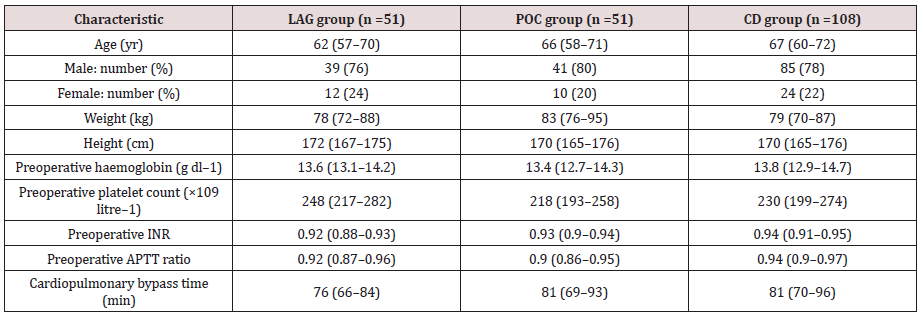
LAG=laboratory algorithm-guided; POC=point of care; CD=clinician discretion; INR=international normalized ratio.
Table 6: T- test.
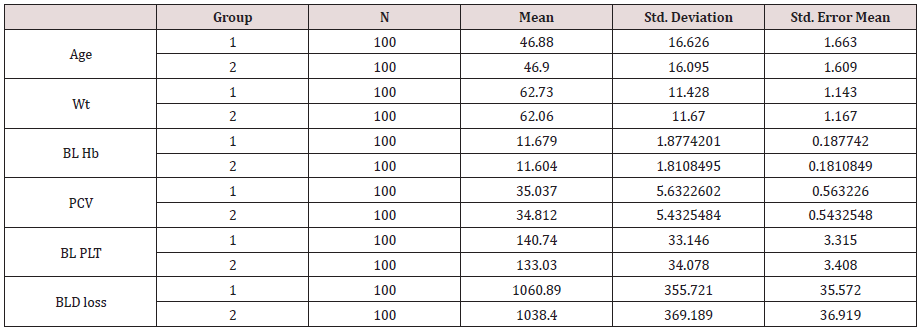
(wt: weight, BL Hb: blood haemoglobin, PCV: Packed cell volume, BL PLT: Blood platelet, BLD loss: blood loss).
Table 7: Test Statistics.

(BL INR: Blood international normalised ratio, BLD TR: blood transfusion, PLT TR: platlet transfusion, FFP TR: fresh frozen plasma transfusion, PO HB: post-operative haemoglobin, PO PLT: post-operative platelet).
User Friendly
The Vigileo monitor and the Pediasat were easy to learn and the learning curve was very short. The use of the monitoring tool was easily explainable to the nursing and paramedical staff, who were able to use it effectively without any problem.
Hours of Post-Operative Ventilation Required for Extubation
The mean duration of post-operative ventilation required for the patient to be extubated with stable haemodynamic parameters in the test group was 48.55 hrs compared to 78.4 hrs for the control group. The maximum duration of post-operative ventilation in test group was 212 hrs, compared to 281 hrs for the control group. While the minimum duration was comparable being 18 hrs for test group and 19 hrs for control group. One-Sample Kolmogorov- Smirnov Test was done in each group to ensure normal distribution due to wide distribution of data.
Discussion
Bleeding is a frequent complication during surgery [1]. Usually more complex the surgery more is the bleed. Consequences of bleeding is exaggerated in moribund and anaemic patients. Surgery, especially complex surgeries are often associated with massive haemorrhage. Although there is no universal definition of massive haemorrhage, Hellstern P et al. [2] has defined it as follows: (i) blood loss exceeding circulating blood volume within a 24-hour period, (ii) blood loss of 50% of circulating blood volume within a 3-hour period, (iii) blood loss exceeding 150 ml/min, or (iv) blood loss that necessitates plasma and platelet transfusion . The intraoperative administration of blood products, including packed red blood cells, platelets, and fresh frozen plasma (FFP), is often live saving. However, blood products are not without complications. Complications of blood transfusions contribute considerably to perioperative morbidity costs4 and blood product resources are limited. Massive haemorrhage is often associated with coagulopathy. Haemorrhage induces loss and consumption of coagulation factors. Once coagulopathy develops, it increases blood loss. Because coagulopathy and blood loss make a vicious circle, prevention of coagulopathy is important.
Large or massive blood transfusion rapidly may cause bleeding due to coagulation disorders. Stored packed red blood cells (PRBC) is deficient in fibrinogen platelets, factor V and factor VIII. Large transfusions of stored blood leads to dilution of these elements [3]. A general indication to transfuse fresh frozen plasma (FFP) is blood loss of more than one circulating blood volume or PT-INR greater than 2.0 [4]. However, in massive haemorrhage, British guidelines recommend that a therapeutic target of PT-INR should be less than 1.5, and that FFP should be given without PT-INR examination when blood loss is anticipated to exceed one circulating blood volume [5]. In such an emergency, we should also consider that thawing fresh frozen plasma will take about 30 min. Deficiency of fibrinogen develops earlier than that of any other coagulation factors: 100 mg/dl after loss of 120-170% of blood volume [6]. Since 5 units of FFP (400 ml) is equivalent to 1 g of fibrinogen, it increases the concentration by about 30 mg/dl in a person weighing 60 kg (circulating plasma volume: 3 L).
Fibrinogens concentrate or cryoprecipitate is preferable when urgent treatment of coagulopathy is required, but volume loading is not desirable. Hence it is often suggested that one or two units of fresh frozen plasma be transfused with every four units of stored blood if volume overload is not detrimental. However not all patients receiving massive transfusion bleed. Mannucci et al. [7] showed that transfusion of FFP to counter haemodilution due to packed cell transfusion does not help. Thrombocytopenia is more likely the cause and not factor V or VIII deficiency in those cases that do bleed. Toulon et al. [8] suggested that the CoaguChek ProDM (a poc INR/PT/PTT device) allows an accurate measurement of PT in patients undergoing haemorrhagic surgical procedures [9]. However, the results were not identical to that obtained from the central laboratory, suggesting that the transfusion algorithms would have to be adapted accordingly. One of the main advantages gained using POC testing in their study is the ability to obtain results more rapidly. Actually, the turn-around time, defined as the elapsed time from blood sampling until availability of the results for the clinicians, was highly significantly shorter for the POC system than for the central laboratory (below 5 min vs. 60 min median value, range: 40->120 min). Finally, the clinical interest of such a pointof- care monitoring of coagulation deserves to be prospectively investigated, especially in connection with the amount of transfused fresh frozen plasma units.
At present POC-OP trial is going on to determine the effectiveness of point of care prothrombin time testing to reduce the administration of FFP. It is a patient and assessor blind, single centre randomized controlled parallel group trial in 220 patients aged between 18 and 90 years undergoing major surgery (any type, except cardiac surgery and liver transplantation) with an estimated blood loss during surgery exceeding 20% of the calculated total blood volume or a requirement of FFP according to the judgment of the physicians in charge. Patients are randomized to usual care plus point of care prothrombin time testing or usual care alone without point of care testing. The primary outcome will be the relative risk to receive any FFP perioperatively. The authors state that inclusion of 110 patients per group will yield more than 80% power to detect a clinically relevant relative risk of 0.60 to receive FFP of the experimental as compared with the control group.
Conclusion
There was no difference in age distribution, sex weight of patients between the two groups. However, the need for blood component therapy was higher in patients who were treated based on clinical discretion than compared to INR guided treatment. The mean duration of post-operative ventilation required for the patient to be extubated with stable haemodynamic parameters in the test group was 48.55 hrs compared to 78.4 hrs for the control group. The maximum duration of post-operative ventilation in test group was 212 hrs, compared to 281 hrs for the control group. While the minimum duration was comparable being 18 hrs for test group and 19 hrs for control group. One-Sample Kolmogorov-Smirnov Test was done in each group to ensure normal distribution due to wide distribution of data.
References
- American Society of Anaesthesiologists Task Force on Perioperative Blood Transfusion and Adjuvant Therapies(2006) Practice guidelines for perioperative blood transfusion and adjuvant therapies. Anesthesiology 105:198-208.
- Hellstern P, Haubelt H (2002) Indications for plasma in massive transfusion.Thromb Res107(Suppl 1):S19-S22.
- Jones J (1987) Abuse of fresh frozen plasma. Br Med J (Clin Res Ed)295:287.
- Spence RK(1995) Surgical red blood cell transfusion practice policiesBlood Management Practice Guidelines Conference. Am J Surg170:3S-15S.
- Irita K, Inada E, Yoshimura H, Warabi K, Tsuzaki K, et al. (2009) Present status of preparatory measures for massive hemorrhage and emergency blood transfusion in regional hospitals with an accredited department of anesthesiology in 2006. Masui58:109-123.
- Stainsby D, MacLennan S, Thomas D, Isaac J, Hamilton PJ (2006) British Committee for Standards in Haematology. Guidelines on the management of massive blood loss. Br J Haematol135:634-641.
- Mannucci PM, Fredrica AB, Sercha G (1982)Haemostasis testing during massive blood replacement, Astudy of 172 cases. Vox surg 42: 113-123.
- CountRB, Harsh C, Simm JL, Maxwel NC,Hermback DM, et al. (1979)Haemostasis in massively transfused trauma patients. Ann Surg 11:275-285.
- Pierre AT, Yves Ozier, Annick Ankri, Marie-Helene Fleron, Genevieve Leroux,et al. (2004) Monitoring of Coagulation during Hemorrhagic Surgery by Central Laboratory and Near-Patient Testing. Results of a Multicenter Study. Blood. ASH Annual Meeting Abstracts104(11): 1043.

Top Editors
-

Mark E Smith
Bio chemistry
University of Texas Medical Branch, USA -

Lawrence A Presley
Department of Criminal Justice
Liberty University, USA -

Thomas W Miller
Department of Psychiatry
University of Kentucky, USA -

Gjumrakch Aliev
Department of Medicine
Gally International Biomedical Research & Consulting LLC, USA -

Christopher Bryant
Department of Urbanisation and Agricultural
Montreal university, USA -

Robert William Frare
Oral & Maxillofacial Pathology
New York University, USA -

Rudolph Modesto Navari
Gastroenterology and Hepatology
University of Alabama, UK -

Andrew Hague
Department of Medicine
Universities of Bradford, UK -

George Gregory Buttigieg
Maltese College of Obstetrics and Gynaecology, Europe -

Chen-Hsiung Yeh
Oncology
Circulogene Theranostics, England -
.png)
Emilio Bucio-Carrillo
Radiation Chemistry
National University of Mexico, USA -
.jpg)
Casey J Grenier
Analytical Chemistry
Wentworth Institute of Technology, USA -
Hany Atalah
Minimally Invasive Surgery
Mercer University school of Medicine, USA -

Abu-Hussein Muhamad
Pediatric Dentistry
University of Athens , Greece

The annual scholar awards from Lupine Publishers honor a selected number Read More...




